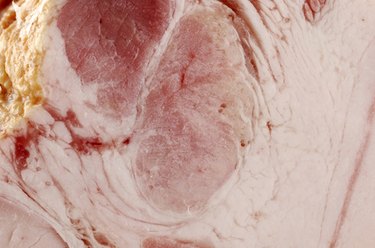Things You'll Need
8 lbs. coarse ground salt
3 lbs. sugar
3 oz. sodium nitrate
Dry ground spices, optional
Bowl
1/2 oz. sodium nitrite, optional
Boneless pork shoulder
Perforated pan or bowl
Pan or bowl that can keep the perforated pan or bowl suspended
Foil or plastic wrap
Refrigerator

Pork shoulder, pork butt and Boston butt are the same cut of meat. Curing this cut at home requires a certain degree of preparation and planning. Curing can be done either dry or wet, but the traditional type of curing is dry salt curing, in which a salt-based cure is rubbed directly on the meat. Curing was traditionally done as a way of preserving meat before the advent of refrigeration. It adds flavor and imparts a desirable pink color to the meat.
Curing Pork Shoulder
Step 1
Make a cure. Combine the salt, sugar, sodium nitrate and desired spices in a bowl. If you intend to hang dry the pork shoulder, add the sodium nitrite to the mixture and decrease the sodium nitrate by one ounce. Sodium nitrate can be found commercially under the names of "tinted curing mix," "pink cure," "Prague powder I" or "Insta-cure #1." Sodium nitrite can be found under the names "Prague powder II" or "Insta-cure #2."
Video of the Day
Step 2
Place the perforated pan or bowl into the second pan or bowl. The bottom of the perforated container should be suspended above the bottom of the second container, so liquid can drain away from the pork shoulder.
Step 3
Using a portion of the cure, liberally apply to all sides of the pork shoulder as well as the top and bottom. There should be no part of the meat that is not coated. Keep the rest of the cure for later. Place the pork shoulder in the pan. Lightly cover with foil or plastic wrap. Store in the refrigerator for one week per inch of thickness of the pork shoulder at its thickest point. A five-inch-thick pork shoulder should cure for a total of 35 days.
Step 4
After three to five days, remove the pork shoulder from the refrigerator. Apply another portion of the cure to the meat. Cover and return to the refrigerator.
Step 5
After another three-to-five-day interval, apply another portion of the cure to the meat, cover and return to the refrigerator.
Step 6
After the third three-to-five-day interval, remove the pork from the refrigerator and set aside. Discard any liquid in the pan, and wash and dry the pans. Return the pork to the pan, cover and return to the refrigerator for the remaining necessary time based upon the thickness of the shoulder. When finished curing, the meat should be slightly salty and pink in color.
Tip
Wash and dry your hands thoroughly before touching any food products. Slicing the shoulder into smaller pieces can decrease the length of time it takes to cure. Wearing disposable gloves can help prevent bacterial transmission when coating the pork with cure. After the curing process is over, you can hang dry the meat or cook it.
Warning
Err on the side of too little sodium nitrite. It is toxic to humans if consumed in excess. If you intend on cooking the cured meat and do not want to hang dry it, do not add the sodium nitrite. It is only required for meat that will be hung to dry.
Video of the Day